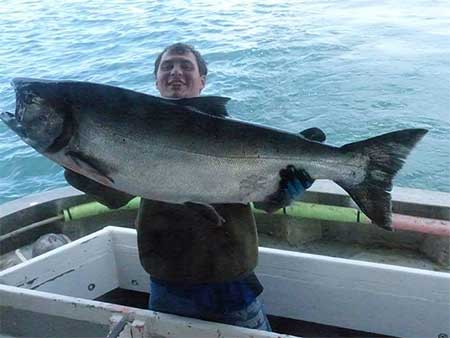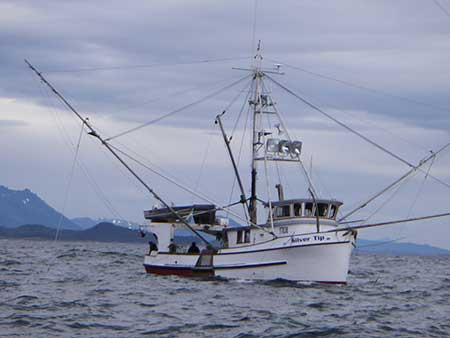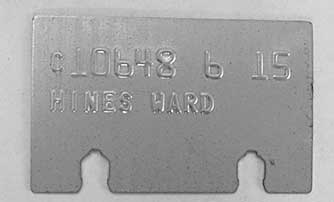Alaska Fish & Wildlife News
March 2016
Selling Alaska Fish All Over the World
Direct Market Fishermen

At ADF&G, fishermen often call with very interesting questions that we don’t know the answer to immediately. This is not because we don’t know our regulations, but because we just have never been asked the question before. Fisherman are creative inventors, often times out of necessity. It is these very traits that prove invaluable to their fishing operations.
Fishermen can harness their creativity and expand their markets by becoming what’s called a Direct Marketer of their commercially harvested seafood. Many fishermen might think that they are limited to selling only to canneries, or offloading to tenders, maybe throw some dockside sales in there and that’s about it. Beginning in 2005, regulations took effect that allowed commercial fishermen expanded opportunities to market their own catch. A specific license type, initiated by the Department of Revenue (DOR) called a Direct Marketing license, allows fisherman to sell their fish to anyone anywhere in the world. Some fishermen have embraced this new opportunity to grow into very successful sole proprietorships. Unfortunately, many fishermen are not aware that having a direct marketer permit can be a great opportunity, or may assume the effort to obtain one is not worth the trouble. In reality, a direct marketer permit is very simple and inexpensive to apply for and to receive. Really, the hardest part of being a direct marketer is catching the fish!
Benefits of a Direct Marketer Permit
As a Direct Market fisherman, you can sell to any individual or company anywhere in the world. Fisherman can process their fish onboard their vessel or at a land based facility. There are no restrictions on who a direct marketer can sell to. Many companies, such as hotels, restaurants, high end grocery stores, etc. are chomping at the bit to be able to claim that their fish was purchased directly from the fisherman and are willing to pay top dollar to do so. As the Seafood Industry Coordinator here at ADF&G, I constantly receive calls from owners of these businesses looking for lists of fisherman that would be willing to work with them. There are markets out there and they are a lot easier to find than one might think.

There are also many wonderful resources available to the fisherman to help promote their sales. There is a state agency called Alaska Seafood Marketing Institute (ASMI) that has dedicated staff and services to assist in promoting the sales of Alaskan seafood. In the information technology age, it’s very easy to set up websites to help these businesses locate you. In fact, many direct marketer fishermen have their catch sold before they even catch it. As the seller, you get to determine your own price and terms. Alan Fisher describes his experience as a direct marketer, “As a commercial fisherman and a self-employed owner-operator of my own business, I enjoy my independence and controlling my own destiny. Being a direct marketer enhances these attributes and makes me feel more empowered.”
Direct Marketers also support local operations that perform custom processing services. Some shore based processing facilities receive a welcome boost to their business by performing custom processing for direct marketer fishermen. Trisha Pearson from the company Fish from Trish located in Ketchikan explains how that process works: “Come to my plant, I can help you out.” She goes on to say how fisherman react to regulations in place from Dept. of Environmental Conservation (DEC) that allow fisherman to be able to process their fish themselves in her DEC approved facility. “Fisherman love being able to fillet their own fish.”
How do I get a Direct Marketer Permit & Why do I Need One?
The minimum qualifications to become a direct marketer are very simple to determine. The vessel responsible for the harvesting must not exceed 65 feet in length and the fisherman must operate as a sole-proprietorship. A sole-proprietorship is a business owned by an individual. The fisherman can set up a business structure, such as an LLC that the direct marketer can sell to, but the initial operation itself must function as a sole-proprietorship. The fisherman must also possess one or more interim use/limited entry permit(s) from the Commercial Fisheries Entry Commission (CFEC), commonly known as a gear card.

If operating from a vessel, the fisherman must also have all vessel licenses required from CFEC, current registration, and assignment of an ADF&G vessel number. That’s it. Most fisherman already have those things anyway.
The application process itself is not complicated. It consists of submitting an application to DOR via their newly released internet based application, Revenue Online. The fee for an approved application is only $25 and takes about 10-15 minutes to submit. ADF&G staff are available and happy to assist with the application process. Once an application is submitted to DOR, the information is reviewed for completeness and then with no action on the part of the fisherman, forwarded to ADF&G for approval. Provided that all necessary information is received, approved direct marketer applications are typically issued in three to seven business days by DOR. ADF&G will then issue the Direct Marketer permit, that day, or within one or two business days. One application satisfies both DOR and ADF&G requirements.
Both ADF&G and DOR have a simple explanation for requiring the fisherman to become a direct marketer. For ADF&G a unique identifier must be associated with the fisherman so that ADF&G can associate harvest with individual fisherman, as opposed to a licensed fish buyer. This unique identifier is called, the processor code. The fisherman will receive a small aluminum tag, just like the ones licensed fish buyers receive, which is then imprinted onto the direct marketer’s fish tickets.

A fish ticket is a form provided by ADF&G that documents commercial harvest. DOR requires that the first processor or exporter is responsible for paying the fisheries business tax. Just as with ADF&G, a unique identifier is assigned to the individual fisherman. This identifier is called the Fisheries Business License number.
What Happens After I Receive my Direct Marketer Permit?
As with any fishing operation you will want to ensure that you follow all applicable regulations from both state and federal agencies. Also you will want to verify any local area reporting or registration requirements with the local ADF&G offices. This is not an extra step, because the act of commercial fishing would require this to occur anyway. It is helpful to have a list of contacts in case any questions come up during your fishing season. After you have ensured that you are in compliance with all regulatory requirements, now it is time to catch fish!
After the Season is Over
Another concern that comes up quite often from direct marketer fisherman is: now that the season is over I’m sure I’ll have a mountain of paperwork to do. This is another false assumption that deters a fisherman from becoming a direct marketer. After the season is over there is one report, called a Commercial Operator’s Annual Report (COAR report) that is required to be submitted to ADF&G. This report is due by April 1st of the year following your operation and is a summary of your sales. The information required on the COAR report is straight from the fish tickets that are submitted to which an average price per pound is added by the fisherman. The DOR requires the Fisheries Business tax return, which is very similar to the COAR report. It may be helpful to take a look at the format of these reports so that your paperwork can be organized during the season making the end of the year process as easy as 1, 2, 3!
Additional Resources

Remember ADF&G & other state agencies are here to help. Becoming a direct marketer is an easy process and is not only beneficial to fisherman, but to the buyers as well. Enjoy the independence of marketing your fish. By becoming a direct marketer you are helping promote Alaskan seafood. Many resources are available to assist fisherman sell their catch that are free and easily accessible. Please do not hesitate to call the Seafood Industry Coordinator at ADF&G to get you started becoming a direct marketer today!
ADF&G
Contact: Shellene Hutter, Seafood Industry Coordinator 907-465-6131, shellene.hutter@alaska.gov
http://www.adfg.alaska.gov/index.cfm?adfg=fishlicense.main
http://www.adfg.alaska.gov/index.cfm?adfg=contacts.main
ASMI - Seattle: 206-352-8920 or Juneau: 907-465-5560
DEC - http://dec.alaska.gov/eh/fss/seafood/Docs/Factsheet-Permitting_Vessels.pdf
Contact DEC: http://dec.alaska.gov/eh/fss/Food/sanstaff.htm
NOAA or 1-800-304-4846
Shellene Hutter is a Fisheries Biologist in Juneau.
Subscribe to be notified about new issues
Receive a monthly notice about new issues and articles.
